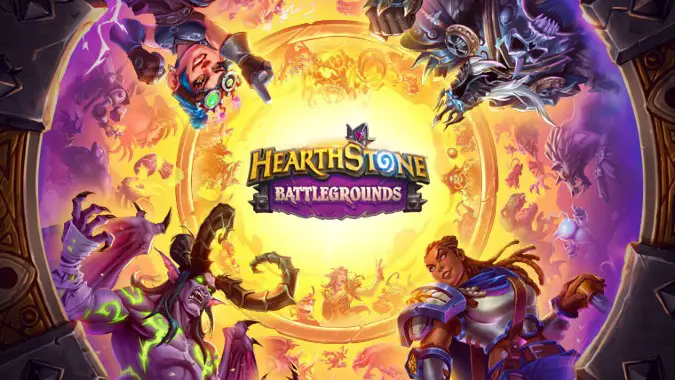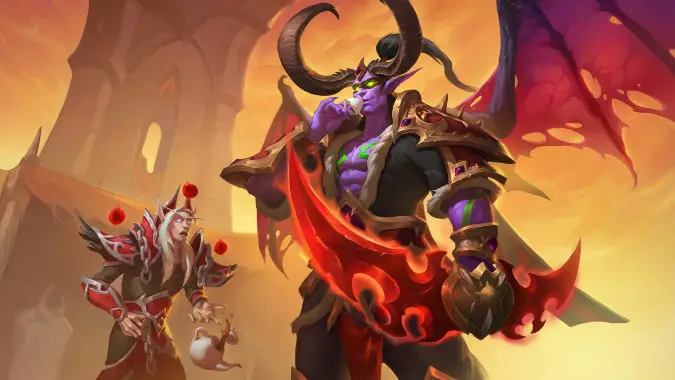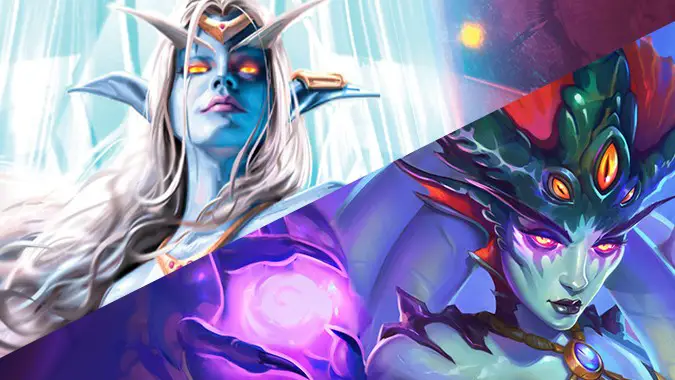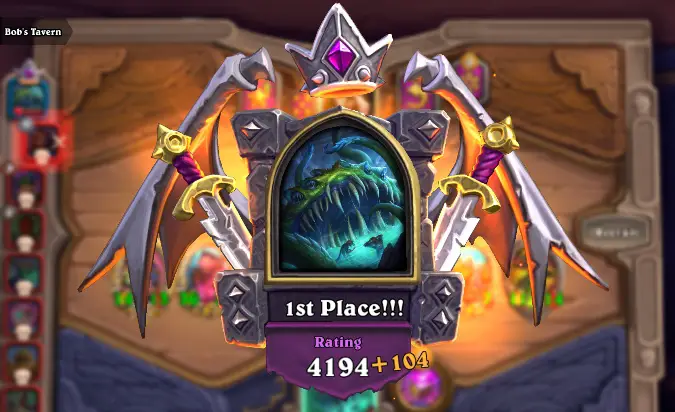How to play (and win!) Hearthstone Battlegrounds

Hearthstone Battlegrounds is the perfect gateway into Hearthstone. Unlike Constructed mode, which requires you to purchase packs, craft cards, and know how to build (and pilot) decks, Battlegrounds is already ripe for anyone to jump into it at any moment. No card collection required: just press “play” to begin!
Does that sound appealing to you? If it does, and you’re interested in giving this mode a try — or if you’re already a player and simply want to learn some tips in order to improve your odds at winning — we’ll present you a brief analysis of how to get started with Hearthstone Battlegrounds — the basics you need to know so you don’t get lost out there.

The basics to begin playing Hearthstone Battlegrounds
Battlegrounds is an auto battler, a subgenre of games where you buy and sell units — in this case, minions — and they fight without your direct input.
- You only make decisions in the Tavern phase, where you must choose which minions to buy or sell, and how to position them on your board.
- Then, during the combat phase, you simply watch as your minions duke it out against one of your opponent’s minions. They attack from left to right, choosing targets randomly. If a player has more minions than the other, they go first; otherwise, it’s random.
- Whoever wins that battle damages their opponent, and then the game returns to the Tavern phase, for more buying, selling, and repositioning.
There are eight players on each game, and each one starts with 40 health (in addition to some Armor, in some cases, which is a balancing tool to give weaker heroes some extra health — and a fighting chance). Whenever a player wins a round of combat, they deal damage to their opponent’s health, and that damage is proportional to the combined might of the minions that survived the battle. The more minions survive — and the higher their Tier is — the more damage is dealt.
When a player’s health is reduced to zero, they are eliminated from the game. You’ll notice that sometimes you’ll fight against the AI-controlled “ghost” of a player that had already been defeated. Although you’re probably going to aim to defeat all seven of your opponents, simply finishing among the top 4 already counts as a win — this is important, since many quests and achievements depend on that. “Win a game of Battlegrounds” effectively means “finish top 4 in a game of Battlegrounds.”
That’s the core gameplay loop of this game mode, but there’s a lot attached to it, as we’ll see below.
What are Heroes and Hero Powers?
The first thing that happens when you start a new match is that you have to pick which hero you want to play as. This is one of the most important decisions in the game, since each hero has their own unique hero power, which drastically changes how they approach the game.
When you’re just getting started, it’s important to simply read the description of each hero power, and pick whichever one feels the most fun — and simple — to you. It doesn’t take too long for you to begin to really appreciate the differences between each hero, and how they can impact things throughout the game.
What are Minions, and what do they do?
Minions are the most important part of the game, since they’re the tool you use to actually win battles. A minion is a creature on the board, with two basic values, represented on the bottom of the card: the number to the left is its Attack, which means how much damage it deals when it hits something else, while the number to the right is its Health, which represents how much damage it needs to take to be killed.
Although minions can be damaged and killed in combat, those are not permanent outcomes: as soon as the current combat ends, those minions will be restored to their initial states and be ready for the next combat.
Most of the time, you get minions by buying them during your Tavern phase. Each minion on the tavern costs three gold, and sells for one gold (with a few rare exceptions that you shouldn’t worry about for now).
Once you buy a minion, it goes into your hand, and you need to play it into the board just like you’d play any Hearthstone card. Once you have multiple minions, you’ll find that you can drag them around to reposition them on the board. This is important because minions always attack from left to right, so you can ensure that some of your minions will attack before others.
Keep in mind that you have a limited amount of room on your board — up to seven minions can be deployed at once, but no more than that, so eventually you’ll hit a point where you’ll want to sell weaker minions to make room for stronger ones.

What is Gold, and how should I use it?
In order to buy minions, or to upgrade your Tavern — more on that later — you use gold. This is not to be confused with the currency that you use outside of the game to buy Hearthstone packs — we’re talking about in-game gold here, which pertains only to the match you’re in.
You start the game with three gold — which is enough to buy one minion — but that amount is increased by one with each new Tavern phase, up to a maximum of ten on turn eight and every subsequent turn. There are certain effects — from minions or other sources — that can generate more gold for you as well.
Your gold is refreshed every turn, so make sure to use all of it! Any leftover gold is permanently lost, which means that you missed the chance to invest that gold into more power, which will hinder you in the long run. Thinking about the economy is one of the most important parts of the game, as you’ll find out as you keep playing.

What kinds of Keywords and abilities do minions have?
Keywords are abilities that affect a minion’s performance in combat — and sometimes outside of it. Battlegrounds uses many of the same keywords as constructed Hearthstone, so if you’re familiar with that mode, you’ll already know most of these.
- Battlecry abilities are triggered at the Tavern, when you play the minion. They’re one-and-done effects that usually serve to buff some other minion, or tamper with your game in other ways.
- Deathrattle abilities are triggered in combat, when the minion dies. They are by far some of the most impactful effects in the game, usually summoning other minions, doling out buffs to your board, or dealing damage to your enemies.
- Discover effects are triggered at the Tavern, and ask you to pick one from three options. So if you’re asked to “Discover a minion,” that means that three minions will pop on your screen, and the one you pick will be added to your hand.
- Divine Shield is a one-time protection from damage (within each combat). If a minion is hit while they have Divine Shield, the shield “pops,” and the minion takes no damage.
- Frenzy effects are triggered in combat, when the minion takes damage and survives. This can only happen once per combat, so if the minion survives damage again within that same battle, the Frenzy effect won’t be repeated.
- Magnetic makes a minion attach itself to a Mech (a minion type, as you’ll see below). The Magnetic minion is lost in the process, but its stats are given to the Mech it was attached to.
- Poisonous is a “touch of death” effect. If a minion with Poisonous deals damage to another minion, the other minion dies, no matter how much health it had left. Divine Shield negates this, since it prevents the would-be poisoned minion from taking damage — but only once.
- Reborn means that when the minion dies, it immediately comes back to life with one health — but without the Reborn keyword, so this only happens once (within each combat). If it had Deathrattle effects when it died, they trigger normally, so the minion can potentially double dip from those.
- Spellcraft is a keyword specific to Naga minions which add spells to your hand that you can play yourself during your Tavern phase. A new copy of that spell is generated on each new phase, so you can use them once a turn for as long as you have that Spellcraft minion on your board.
- Taunt means that this minion will be attacked before minions that don’t have Taunt. Basically, your minions with Taunt will draw attacks in order to protect the rest of your board. A few specific minions have attacks that can bypass Taunt, but it isn’t common.
- Windfury means that this minion will attack twice — the second attack occurs right after the first. There’s also the rarer Mega-Windfury keyword, which means that the minion can attack up to four times at once.
But beyond those basic keywords, many minions have other abilities that are expressed in their card text, and are usually unique to them. You need to learn them as you play, but most are pretty simple to grasp.

What does it mean to “Refresh” or “Freeze” the Tavern?
During your Tavern phase, if you’re not satisfied with the minions that are offered to you, you can click the Refresh button at the top right of the screen to get a new selection — but doing so costs one gold, so be wary of doing it too much!
Especially early in the game, it’s usually better to just invest your gold into some minions — any minions — than waste it by refreshing too much. As the game progresses, Refreshes become more useful as you already have a satisfactory board to do battle with, and you’re looking for specific minions to buy.
Similarly, sometimes you’ll see a minion that you want to buy but don’t have the gold for yet. In that case, you can press the other button found at the top right of the screen, which is the Freeze button. This ensures that the next time you return to the Tavern phase, those minions will still be there, and you’ll get another opportunity to buy them.
Unlike refreshing, freezing the Tavern doesn’t cost any gold. And if you change your mind, you can always click the button again to unfreeze those minions.

What are Tavern Tiers, and how do they affect the game?
Minions have different Tiers, from one to six — represented by the stars you can see on the top left of each minion card. This is the most basic measurement of how powerful they are: while a Tier 1 minion is just a starter troop to do some damage early on, a Tier 6 minion can single-handedly carry you to many victories.
You only get access to higher Tier minions by upgrading your Tavern — a Tier 2 Tavern will offer Tier 2 minions in addition to Tier 1 ones, etc., so eventually you’ll need to upgrade all the way to Tavern Tier 6 in order to be offered Tier 6 minions to buy.
Upgrading your Tavern cost gold, and that cost is prohibitively high at first. But the cost goes down by one gold each turn, so it eventually becomes cheap enough that it’s a worthy investment. Knowing when to upgrade your Tavern is one of the most skill-testing aspects of the game: do it too early and you’ll be able to access the strongest minions before your opponents do, but you’ll have to pay a hefty gold cost to do so, which will probably leave you at a big disadvantage at the present moment. You need to keep playing games and measuring the risk vs. reward factor of how early you need to upgrade based on how things are going in your current game — that skill will be developed with time.
There’s a limited number of copies of each minion in the game, and the number gets smaller the higher tier it is! So when you’re buying a minion, you’re removing it from the pool for all players — which has great strategic implications. If you see that two or more other players are playing Dragons, you might have a hard time finding your own Dragons to buy, so it might be a good idea to consider playing some other minion composition. Selling a minion, however, returns it to the pool for everyone as well.
What are Triples and Golden Minions?
You’ll notice that you can buy multiple copies of the same minion, but when you’re about to buy the third copy of one, that copy will have a glowing effect. This indicates that you’re about to hit a triple: all three copies of your minion will fuse together and become a single golden minion, which is (usually) twice as powerful as a regular copy, while occupying a single space on the board!
There’s another benefit to this: whenever you play a golden minion on the board, you get to Discover (that is, pick one from three options) a minion from a Tavern Tier higher than what you’re currently at! So if you hit a triple at Tavern Tier 4, for instance, you’ll be given the chance to pick one extra minion that comes straight from Tier 5. This is crucial for making your board stronger throughout the game, and something that you should always be aiming for.
What are the minion types, and what are compositions?
Most minions have a type, which is written at the bottom of the card. Right now, there are nine minion types in the game: Beast, Demon, Dragon, Elemental, Mech, Murloc, Naga, Pirate, and Quilboar.
- Beasts usually work through the Deathrattle keyword, by summoning more Beasts or buffing your existing ones — or both at the same time.
- Demons like to consume other minions in the Tavern in order to grow stronger. They also grow stronger as they summon other demons in combat, and sometimes they use “juggles” to randomly hit enemy minions as friendly demons die.
- Dragons tend to grow a lot in power throughout the game. During combat, they can deal damage to enemies before hitting them, and they also have a penchant for Divine Shields and for permanent buffs.
- Elementals are the premier minion type when it comes to big stats. Each Elemental you summon tends to make the next one bigger and bigger, until they reach ridiculous Attack and Health levels. They also love Windfury attacks.
- Mechs can summon lots of other Mechs during combat while also providing buffs — much like Beasts. But they also shine through Divine Shields, even more so than Dragons, since they can keep re-adding Divine Shield many times during combat.
- Murlocs are all about Poisonous attacks: they’re very deadly creatures that can take down giant enemy minions with this nasty keyword, but they can also buff themselves a lot if left unchecked.
- Naga love spells. They’ll thrive through the Spellcraft keyword, adding all sorts of different effects and buffs to your warband during combat.
- Pirates, on the other hand, love gold: when you’re playing them, the economy game becomes much more complex and powerful since you’ll be earning lots of extra gold, and buffing your minions with each purchase. They can also buff your whole board before every attack.
- Quilboar are the masters of Blood Gems, which are buffs you can cast yourself, and which they can generate both in combat and on the Tavern phase. Beware of Divine Shields and Windfury attacks from them.
In the majority of cases, minions have certain synergies that make them work better with other minions of the same type. Those synergies are so important that most players will usually try to stick to a single type for their whole board, so that their minions can feed power to one another, exponentially increasing how efficient they are. This is what we call a “composition,” or “comp:” if a player is playing a lot of Murlocs, for example, we say that they’re playing a “Murloc comp.” (There are also “Menagerie” comps, which try to have exactly one minion of each type, but those are a bit harder to make work most of the time.)
Not every type will be offered to players on every game, however. As soon as a game starts, during the hero selection phase, you’ll already be informed of which types are or aren’t present on the current game, and plan accordingly. This is another very important aspect of the game, since certain minion types — or “tribes,” as they’re sometimes called — can work as counters to others. You’ll learn more about those synergies and counters as you keep playing.
What are Seasonal events, and how do they work?
Hearthstone Battlegrounds operates in seasons, and every now and then, a Seasonal event will occur that dramatically changes how games are played.
We’ve had three types of events so far: Darkmoon Prizes, Buddies, and Quests. Right now, we’re in Season 2, and Quests are the active event.
Quests
While this event is active, three Quests are offered to all players on turn four, and they have to pick one. Each Quest entails a series of objectives you need to fulfill during the game, such as “summon 20 minions” or “have your friendly Taunt minions attacked 12 times.”
Each Quest also comes paired with a specific reward, such as “your minions have +5 attack” or “you only need two copies of a minion to make it golden.” More powerful rewards have much steeper requirements.

General tips on how to win more games in Hearthstone Battlegrounds
These are some general tips aimed at players who are just getting started — more advanced players will probably break some of those as they see fit, but you need to know the rules before you can venture into breaking them. And, of course, the key is to practice a lot!
- It’s useful to position your minions so that the strongest ones are further to the left, to ensure that they attack first — but as you keep playing you’ll find many exceptions to that rule.
- Try not to take too long before you raise the level of your tavern. Starting from Tier 2, a good rule of thumb is: if you see that you can upgrade your tavern and still have three gold left — enough to buy a minion — it’s time to do it.
- Don’t try to force a specific composition if you can’t find the pieces! This is a common mistake players make. Keep your options open during the beginning of the game: simply buy whichever minions are the strongest for the time being, instead of going out of your way to ensure that you’re playing Beasts, or Demons, or whatever. Early on, you should try to find synergies if you can, but you shouldn’t overdo it.
- Know the ins and outs of your hero: try to keep playing the same hero as often as you can, instead of changing heroes too much. Certain heroes are harder to play than others, and you’ll need to get some experience with concepts such as when to use your Hero Power, when to raise your Tavern Tier, etc.
Battlegrounds is a far more forgiving mode than Constructed is; you don’t get as much anxiety since it’s a lobby of eight players, rather than just you vs. a single opponent. And finishing top 4 counts as a win, which definitely alleviates the pressure: winning is a spectrum, rather than a simple “yes or no” answer. You can win by playing a perfect game and smashing the competition, but you can also win by barely scraping by and finishing fourth against three opponents who are doing much better than you!
Originally posted September 30, 2021. Updated September 8, 2022.
Please consider supporting our Patreon!
Join the Discussion
Blizzard Watch is a safe space for all readers. By leaving comments on this site you agree to follow our commenting and community guidelines.
 @harmonicstrike
@harmonicstrike









